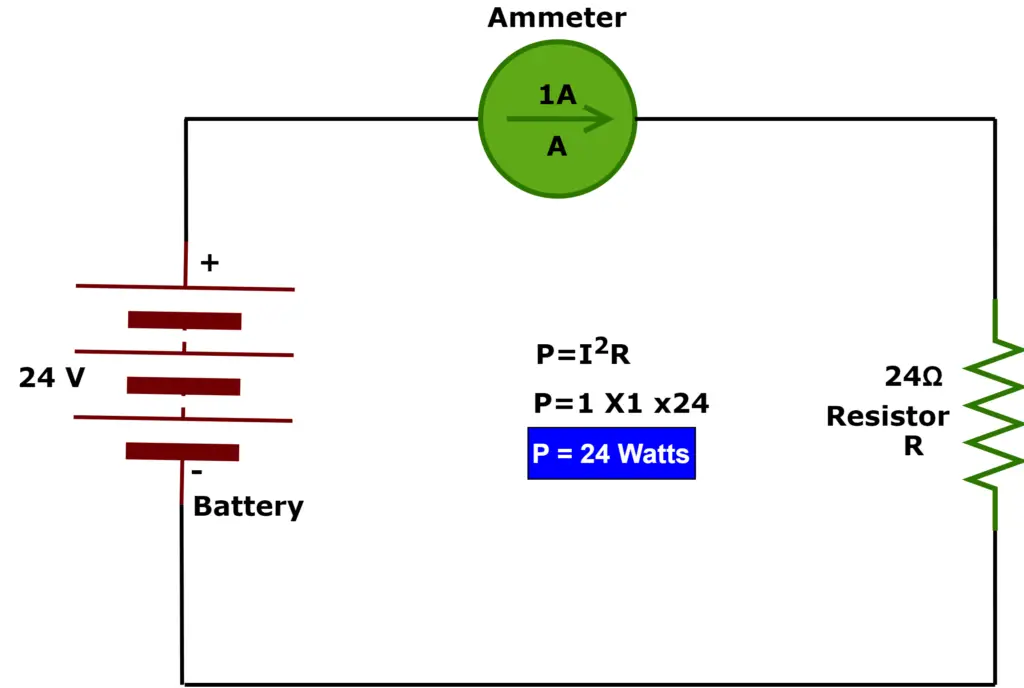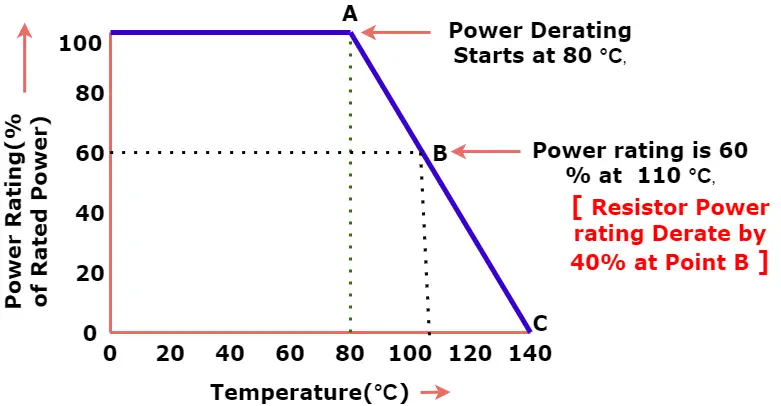The power rating of a resistor indicates the maximum heat energy that a resistor can dissipate in the surroundings without fail. The heat dissipation depends on the power rating and the ambient temperature. The higher ambient temperature causes less heat dissipation, leading to the burning of the resistor.
In this article, we will discuss the resistor power rating, its formula, and its significance. As we know, the resistor is an electric circuit element that generates heat when an electric current passes through it. In a resistor, the amount of heat generated depends on the current flowing through it. In other words, we can say that a resistor converts electrical energy into heat.
The heat dissipation in the resistor is a waste of electric energy. However, you can not avoid this. When current flows through the resistor, the entire length and cross-section area of a resistor create hindrance to electrons, and heat dissipation takes place in the resistor. Yes, for some of the applications like water heaters and space heaters, the resistor’s property of converting electrical energy into heat is useful.
What is Resistor Power Rating?
The measure of the capability of a resistor to convert electrical energy into heat is termed the power rating of the resistor or the wattage rating of the resistor.
In practice, the resistors are rated in terms of watts (W), and the value of the resistor specified in terms of watts is the maximum amount of heat the resistor can dissipate without getting damaged.
For every resistor, there is a maximum value of electric power specified that the resistor can handle safely. More specifically, the wattage rating of a resistor depends on its physical size.
It is a fact that if the resistor has a larger physical area, then it can dissipate a higher amount of electric power and, hence, its power rating will be higher.
For the safe operation of a resistor, the amount of heat generated by the resistor must not exceed its power rating. The power rating of a resistor is also termed the wattage rating of the resistor.
The wattage rating of a resistor can also be defined as the amount of heat energy that the given resistor can dissipate infinitely by radiation, convection, and conduction without getting damaged or decreasing efficiency.
You would have observed that the temperature across the resistor’s body is not uniform. You will find the resistor’s body hotter than its terminal and the maximum temperature at the center of the body. The rise in temperature of the resistor must not exceed the specified permissible value. The temperature rise above the rated value causes an increase in the resistance value and affects the circuit performance. Therefore, heat dissipation to the environment is an important factor for the reliable operation of resistors.
In actual practice, most real resistors have their wattage rating specified for a surrounding temperature of +70 °C or lower.
Units of Resistor Power
As we already mentioned, the resistor power rating is usually expressed in watts (W). However, several other smaller or larger units are also being used to specify the resistor’s wattage rating.
The following table gives some of the most commonly used units for expressing the power rating of resistors in practical applications:
| Unit | Symbol | Value | Scientific Notation |
| Milli Watt | mW | 1/1000th Watts | 1 × 10-3 W |
| Kilo Watt | kW | 1000 Watts | 1 × 103 W |
| Mega Watt | MW | 1,000,000 Watts | 1 × 106 W |
| Giga Watt | GW | 1,000,000,000 Watts | 1 × 109 W |
How to Calculate Resistor Power Rating?
Now, let us discuss how we can compute the wattage rating of a resistor.
There are several different ways of calculating the power rating of a resistor. The simplest one is Ohm’s law. The formula for calculating the wattage rating of a resistor can be derived using Ohm’s law as follows:
Let us consider a resistor subjected to a voltage of V volts, and an electric current of I amperes flows through it. Then, the resistor wattage can be given by the product of voltage across and the current through the resistor, i.e.,

Also, as per Ohm’s law,

Where R is the resistance of the given resistor in Ohms.
Then, the resistor power rating will be,

And,

Using any of these three formulas, you can easily calculate the wattage rating of the resistor. The wattage rating is calculated in the circuit diagram below.

In practical applications, we always select a resistor with a power rating two or three times the calculated power rating for its safe operation in the circuit.
Types of Resistors and Their Power Ratings
The following are some common resistor types used in electrical and electronic circuits. We have specified their power ratings:
- Metal Film Resistors – These resistors have a very low power rating, typically less than 3 Watts, with relatively high stability. Hence, they are widely used in small electronic circuits.
- Carbon Resistors – The carbon resistors also have a low wattage rating, usually less than 5 watts, but have lower stability than metal film resistors. These are also suitable for small electronic circuits.
- Wirewound Resistors – The wire wound resistors are considered high power resistors and provide high resistance stability. Therefore, they are used in high-power electric circuits.
- Power Resistors – Power resistors are a special type of wire wound resistors designed to handle a high amount of power, up to 1000 watts or more. These resistors are made to have a larger physical area to dissipate a high amount of heat generated. They are widely used in motor control circuits, electromagnets, motor braking circuits, and more.
Resistor Power Derating
As discussed, the nominal wattage rating of the resistor is specified at a certain ambient temperature. For example, the power rating of a resistor is 10 watts at 75°C, and if you operate it at the ambient temperature of 90°C, does the resistor capable of dissipating the amount of heat generated in its body? The heat transfer rate will slow, and the resistor will eventually fail. You will observe that the resistor’s body gets more hotter at 90°C. This effect is known as derating.
Now, if you want to use the same resistor at increased temperature at 90°C ambient temperature, you need to reduce the amount of heat generation by reducing the current flowing through it. Thus, the heat dissipation rating of the resistor decreases with a rise in ambient temperature, as shown in the below graph.

The other factors that impact the resistors’ wattage deratings are as follows.
- The electrical circuit is enclosed in an enclosure. The heat transfer takes from the resistor’s body to the enclosure wall to ambient temperature. Thus, an enclosure creates a hindrance to the flow of heat. The design parameters of the enclosure, like its size, shape, material, wall thickness, and orientation, affect the heat transfer rate.
- The types of cooling arrangements affect the wattage rating. The natural air circulation has slower heat dissipation than the forced cooling.
- When the resistors are installed close to each other, the resistor receives the heat of other resistors and affects the heat transformer. The resistors can be installed sparsely in a circuit to improve the heat transfer rate.
- At altitude, the heat transfer happens only through radiation, and above 30 KM, the heat transfer rate is adversely affected.
Solved Problems of Wattage Rating
Now, let us consider some numerical examples to understand how to calculate the wattage rating of a resistor.
Numerical Example(1)- A resistor is subjected to a voltage of 24 V and a current of 2. A flowing through it. What is the maximum power rating of this resistor?
Solution – Given data,
V = 24 V
I = 2.5 A
The maximum wattage rating of the resistor is,
P = V × I
= 24 × 2.5
P= 60 W
Numerical Example (2) – Calculate the maximum power rating of a resistor of 100 kΩ when a 220 V supply source is connected across it.
Solution – Given data,
R = 100 kΩ
V = 220 V
The maximum wattage rating of the resistor will be,

Hence, this is all about resistor power rating, its formula, and its significance. Every resistor has a specified wattage rating that must not be exceeded to avoid failure of the resistor.